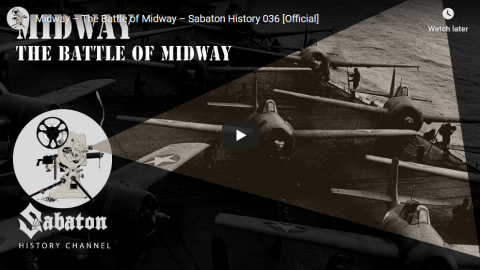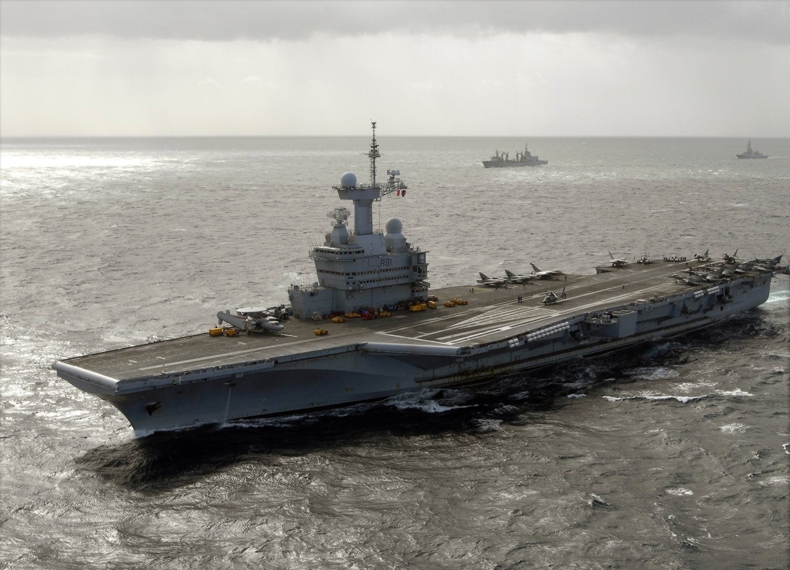Sabaton History
Published 11 Oct 2019The Battle of Midway in June 1942 was one of the decisive battles on the Pacific front during World War Two. The Sabaton song “Midway” is about that battle and the men who sailed, flew, fought and died there.
Support Sabaton History on Patreon: https://www.patreon.com/sabatonhistory
Listen to Coat of Arms (where “Midway” is featured):
CD: http://bit.ly/CoatOfArmsStore
Spotify: http://bit.ly/CoatOfArmsSpotify
Apple Music: http://bit.ly/CoatOfArmsAppleMusic
iTunes: http://bit.ly/CoatOfArmsiTunes
Amazon: http://bit.ly/CoatOfArmsAmzn
Google Play: http://bit.ly/CoatOfArmsGooglePlayWatch the Official Lyric Video of Midway here: https://www.youtube.com/watch?v=0WAfB…
Listen to Sabaton on Spotify: http://smarturl.it/SabatonSpotify
Official Sabaton Merchandise Shop: http://bit.ly/SabatonOfficialShopHosted by: Indy Neidell
Written by: Markus Linke and Indy Neidell
Directed by: Astrid Deinhard and Wieke Kapteijns
Produced by: Pär Sundström, Astrid Deinhard and Spartacus Olsson
Creative Producer: Joram Appel
Executive Producers: Pär Sundström, Joakim Broden, Tomas Sunmo, Indy Neidell, Astrid Deinhard, and Spartacus Olsson
Maps by: Eastory
Edited by: Iryna Dulka
Sound Editing by: Marek KaminskiEastory YouTube Channel: https://www.youtube.com/channel/UCEly…
Archive by: Reuters/Screenocean https://www.screenocean.com
Music by Sabaton.Sources:
National Security Agency
Letter icon by Mochammad Kafi from the Noun Project
Ship icon by Edward Boatman from the Noun ProjectAn OnLion Entertainment GmbH and Raging Beaver Publishing AB co-Production.
© Raging Beaver Publishing AB, 2019 – all rights reserved.
October 12, 2019
“Midway” – The Battle of Midway – Sabaton History 036 [Official]
May 11, 2019
Balkans, Bazookas, and Bunkers – WW2 – OOTF 002
World War Two
Published on 9 May 2019Out of the Foxholes is back to answer your questions about the war. In this episode, we take a look at anti-tank weaponry for infantry, the German defensive lines of the Westwall, the never-finished German aircraft-carrier Graf Zeppelin and the Balkans. The Chieftain, who has his own YouTube channel about tanks and armored vehicles, joins us to answer some of your technical questions. Do you have any questions of your own? You can submit them here: https://community.timeghost.tv/c/Out-…
Join us on Patreon: https://www.patreon.com/TimeGhostHistory
Or join The TimeGhost Army directly at: https://timeghost.tvCheck out The Chieftain on Youtube: https://www.youtube.com/user/TheChief…
Follow WW2 day by day on Instagram @World_war_two_realtime https://www.instagram.com/world_war_t…
Join our Discord Server: https://discord.gg/D6D2aYN.
Between 2 Wars: https://www.youtube.com/playlist?list…
Source list: http://bit.ly/WW2sourcesWritten and Hosted by: Indy Neidell
Produced and Directed by: Spartacus Olsson and Astrid Deinhard
Executive Producers: Bodo Rittenauer, Astrid Deinhard, Indy Neidell, Spartacus Olsson
Creative Producer: Joram Appel
Research by: Joram Appel
Edited by: Wieke Kapteijns and Spartacus OlssonArchive by Screenocean/Reuters https://www.screenocean.com.
A TimeGhost chronological documentary produced by OnLion Entertainment GmbH.
From the comments:
World War Two
Out of the Foxholes is back! While we can’t make this into a regular thing yet, releasing one on set days and stuff, we love doing them and will publish one whenever we find some time to make them. In this edition, The Chieftain joins us to tackle some of the technical questions we have received. Did you know that the Chieftain has made several special episodes about tanks and tactics leading up to World War Two on his own channel? You can find that right here: https://www.youtube.com/user/TheChieftainWoT
If you want to submit a question of your own, you can do that right here: https://community.timeghost.tv/c/Out-of-the-Foxholes-QsPlease consider supporting us on Patreon, as this project is almost fully driven by the financial support we receive on there. You can find our Patreon page right here: https://www.patreon.com/TimeGhostHistory
Cheers,
Joram
May 10, 2019
Operation Pedestal: The Convoy That Saved Malta
Historigraph
Published on 6 Apr 2019If you enjoyed this video and want to see more made, consider supporting my efforts on Patreon: https://www.patreon.com/historigraph
Join the Historigraph Discord: https://discord.gg/vAFTK2D
#OperationPedestal #Historigraph
► Twitter: https://twitter.com/historigraph
► Patreon: https://www.patreon.com/historigraph
► Discord: https://discord.gg/vAFTK2D
► My Twitch: https://www.twitch.tv/addawaySources:
Jonathan Dimbleby, The Battle of the Atlantic.
Correlli Barnett, Engage the Enemy More Closely
James Holland, The War In the West Volume 2
naval-history.netMusic:
“Rynos Theme” Kevin MacLeod (incompetech.com)
Licensed under Creative Commons: By Attribution 3.0 License
http://creativecommons.org/licenses/b…
March 13, 2019
German politician floats the idea of a Franco-German aircraft carrier
Hmmm. What could they call it? The Charlemagne? The Louis XIV? The Napoleon? The Friedrich der Große? The Wilhelm II? The Maréchal Pétain? The possibilities are endless…
France and Germany should band together and build a European aircraft carrier to boost the continent’s defense capabilities, according to Annegret Kramp-Karrenbauer, a confidante and possible successor to German Chancellor Angela Merkel.
Kramp-Karrenbauer, who leads the Christian Democratic Union since Merkel stepped down from that job last fall, pitched the idea in a Sunday commentary in the Germany newspaper Die Welt. The article was meant as a response to French President Emmanuel Macron’s plea days earlier toward something of a European renaissance ahead of the European Parliament’s elections in May.
“Germany and France already are working on a future European combat aircraft, where other nations are invited to join,” Kramp-Karrenbauer wrote, referring to the Future Combat Air System, or FCAS. “As a next step, we could start the symbolic project of building an aircraft carrier to give shape to the role of the European Union as a global force for security and peace.”
On the one hand, the French navy (the Marine Nationale) does have current experience operating an aircraft carrier, the Charles de Gaulle, although a second carrier was cancelled due to budget constraints. The German navy, however, has been reported to be in dire straits both financially and operationally. I suspect it would take even longer than the time elapsed to negotiate, design, and build a carrier to get the German navy sufficiently well-staffed and trained to bear their part in the shared operations.
It has taken the Royal Navy several years of preparation — including much-needed allied assistance with crew members serving on US Navy carriers — to ensure that the latest British carrier, HMS Queen Elizabeth could be properly manned for working-up toward a first deployment next year. Aircraft carriers are not just bigger ships: they’re a unique type of ship and you don’t just build one (setting aside the highly specialized design requirements and finding a shipyard big enough) and then crew it with matelots from your existing fleet of frigates, corvettes, and patrol boats. I don’t think it’s expected that the Royal Navy will be able to operate both Queen Elizabeth and HMS Prince of Wales simultaneously except for brief operational surges or full-scale war.
Of course, I’m far from the only doubter about this idea:
“The ‘European aircraft carrier’ is such a ridiculous and meaningless proposal (don’t get me wrong, I can imagine some French politicians having the same ‘idea’) that it does not even deserve a rebuke,” Bruno Tertrais, deputy director at the Paris-based Fondation pour la Recherce Strategique, wrote in an email to Defense News.
Ulrike Franke, a London-based defense analyst with the European Council on Foreign Relations, struck a similar chord in a Monday post on Twitter: “I am all for strengthening European capabilities, yes please. … But this appears … not particularly well thought through…?”
And Wolfgang Ischinger, former German ambassador in Washington and doyen of the Munich Security Conference, suggested Germany wouldn’t really know what to do with such a ship.
“An aircraft carrier is an instrument of geopolitical/military power projection,” he wrote on Twitter. “A precondition for the employment would be a common strategy and decision-making process — Germany is light years away from that!”
That appears to be the crux of Germany’s defense debate: The Bundeswehr is so caught up in its disrepair that there is no space for formulating the kind of national strategy against which new capabilities could be evaluated. The lack of such a reference point gives all new military technology — from drones to artificial intelligence to naval power projection — the whiff of being far-fetched from the start, rightfully or not.
HMCS Bonaventure – Canada’s Last Aircraft Carrier
Ganarly Films
Published on 10 Apr 2016How Canada’s Government could be so short-sighted? A brief history of HMCS Bonaventure.
February 25, 2019
HMCS Bonaventure of the Royal Canadian Navy
Sneaky Loon
Published on 9 Apr 2017The Bonaventure was purchased from the Royal Navy to replace HMCS Magnificent because the Bonaventure could operate fighter jets to conduct anti-submarine activities.
January 24, 2019
The Sinking of HMS Glorious: An Avoidable Tragedy?
Historigraph
Published on 27 Aug 2018The Sinking of HMS Glorious, on June 8 1940, was one of the worst British naval disasters of the Second World War. Over 1500 losing their lives as two German battleships sunk three British ships. In this video, we will recount the events and the heroism of Glorious’ two escorts (HMS Ardent and HMS Acasta), before looking at the post-war controversy over whether the disaster was ‘covered up’ by the Admiralty.
If you enjoyed this video and want to see more made, consider supporting my efforts on Patreon: https://www.patreon.com/historigraph
► Twitter: https://twitter.com/historigraph
►Patreon: https://www.patreon.com/historigraph
►Discord: https://discord.gg/f8JZw93
►My Gaming Channel: https://www.youtube.com/c/AddawaySources:
John Winton, Carrier Glorious (Cassell: 1986)
Stephen Roskill, Churchill and the Admirals (Pen and Sword, 1977)
Corelli Barnett, Engage The Enemy More Closely: The Royal Navy in the Second World War (Penguin, 1991)
Henrik Lunde, Hitler’s Preemptive War: The Battle for Norway, 1940. (kindle edition)
Earl Ziemke, German Northern Theater of Operations 1940-1945. (kindle edition)
Record of the Hansard Debate from 1999: https://api.parliament.uk/historic-ha…
Full Casualty List for HMS Glorious can be found here: http://www.naval-history.net/xDKCas19…
From the comments:
1. Unlike the Battle of the River Plate from my last video, we do not know the precise movements of the ships, particularly the British ones, during the battle. The movements in this video should thus be taken as purely illustrative.
2. As you might be able to tell there is still a pretty intense debate over the reasons for Glorious’ sinking, particularly over what knowledge the officers on board Devonshire had or didn’t have about Glorious’ trouble. In particular there is testimony from one midshipman that the ship’s captain and Admiral Cunningham (who was on board) knew what was happening and took no action. It is only his word, so many of the historians I have read do not seem to have bought much into it, but it appears in this documentary from 1997: https://www.youtube.com/watch?v=1yAahSUiXt4
October 27, 2018
HMS Queen Elizabeth to depend on Shock! Horror! Dutch escort!
At the Thin Pinstriped Line, Sir Humphrey explains to “Disgusted of Tunbridge Wells” and all the other would-be Admirals of the Fleet why having a non-RN escort for Britain’s newest aircraft carrier is hardly a bad thing:
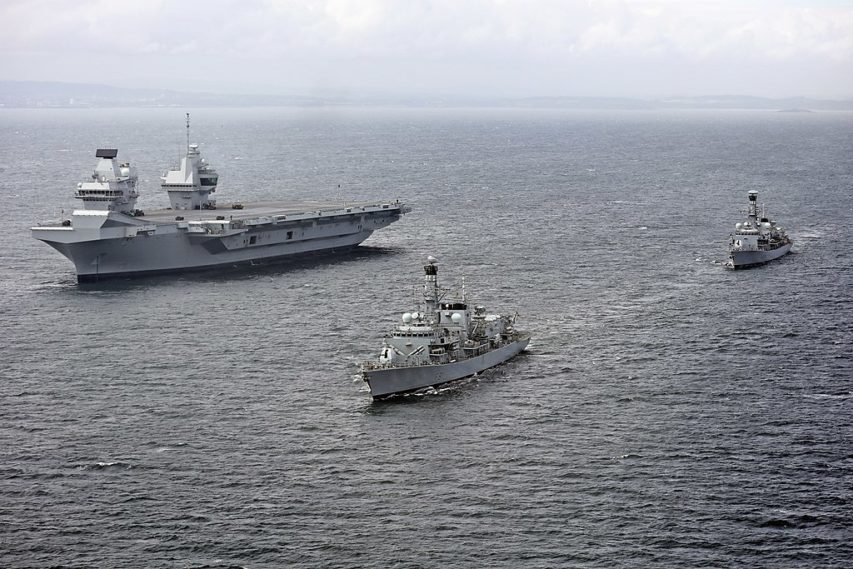
Aerial view of HMS Queen Elizabeth with Type 23 frigates HMS Iron Duke (centre) and HMS Sutherland (right) in June 2017 off the coast of Scotland.
Photo by MOD via Wikimedia Commons.
The United Kingdom has few allies closer than the Netherlands. Both nations are modern, outward looking and instinctively maritime in their view of the world. Long standing NATO partners and with significant experience of working together across the globe, the Netherlands Armed Forces are highly respected as being capable, well equipped and staffed with first rate personnel.
The relationship between the RN and the Royal Netherlands Navy is extremely close, particularly between the Marine Corps and the Submarine Services. It is therefore extremely pleasing to hear that the Netherlands will be deploying a warship to form part of the inaugural ‘Carrier Strike Group’ (CSG) deployments for HMS Queen Elizabeth in 2021 HERE. This is a significant announcement and it has several ramifications that are good news for the Royal Navy.
[…]
There seems to be an exceptionally British trait of moaning at good news. Some people felt that it wasn’t good enough for the RN to be ‘reliant’ on a foreign warship operating as part of the CSG, and that the UK should be going it alone. What utter rot.
It does not mean, despite what some naysayers were desperate to bleat about on social media without any evidence to the contrary, that defence cuts mean the UK is reliant on the Dutch to protect the carrier. The RN has spent a lot of time working out what escorts are needed and ensuring they will be available when necessary as part of the CSG to properly protect the carrier. Any foreign participation is a nice bonus capability to have, not a tacit hint that the RN is short of ships.
The reality of future operations is that the UK is going to operate as part of an international coalition with our friends and allies. Despite the fantasies of some, desperate to see a huge purely British task force sailing around the world looking for a fight and a free trade deal, the fact is that any future military operation is going to be international by design.
Working with allies is critically important but isn’t something you can just do at the drop of a hat. One of the reasons why NATO works so well is because it has spent 70 years investing in common processes, tactics and procedures and exercising them regularly to ensure everyone can work together coherently.
Integrating a Dutch vessel now is vital because it helps build and cement an understanding at operational level of how to work with each other, to learn the capabilities of each other’s ships and how to work them to best effect together. It can also spot unintended issues or problems and help work out how to fix them quickly. This takes time to do, so it is likely that any Dutch vessel assigned in 2021 will have spent a considerable period working up in advance before beginning the deployment proper.
For those who complain that the Royal Navy hasn’t got enough ships to escort the carrier, it is worth reflecting that the Netherlands have a total of 6 frigates. Assuming the normal serviceability rates for escorts apply, then two are likely to be in refit and another in maintenance or training. This leaves just three active vessels at any one time – so in reality, the Netherlands commitment to support the Carrier Strike Group represents them committing a third of their available escort force for a significant amount of time.
October 9, 2018
The Falklands – MiniWars #1
OverSimplified
Published on 22 Oct 2017“HEY OVERSIMPLIFIED, WHERE’S WW2?!”
Don’t worry, WW2 is still coming! Here’s a little something in the meantime!If you would like to see more OverSimplified on a more regular basis, please consider supporting me on Patreon (Patreon rewards coming soon):
https://www.patreon.com/OverSimple
September 26, 2018
The last British carriers before the Queen Elizabeth class
This is a long, long thread from @EngageStrategy, so I’m putting it below the fold for those who aren’t interested and don’t want to scroll down for hours…
It covers the near-death experience of British carriers in the 1960s (the cancellation of the last fleet carriers), the odd evolution of the “through deck command cruisers” (Invincible, Illustrious, and Ark Royal), the development of the Harrier, and the very near-run thing that was the carriers’ share of combat duty during the Falklands War.
September 15, 2018
Battle of Saipan – Suicide Island – Extra History – #2
Extra Credits
Published on 13 Sep 2018This series is brought to you by World of Tanks PC. Check out the game at the link below and use the invite code FORAGER for extra goodies. https://redir.wargaming.net/r06pve1j/…
As the ruthless clash of the Saipan invasion drags on into the second week, a unique and unlikely hero emerges. Marine scout Guy Gabaldon can speak Japanese. He deserts his post, not once but twice, to reach out to the enemy soldiers and civilians.
September 10, 2018
HMS Victorious Receives New Strike Force (1966)
British Pathé
Published on 13 Apr 2014Full title reads: “Moray Firth. ‘Victorious’ Receives New Strike Force”.
Moray Firth, Scotland.
Air view Royal Navy warship, the aircraft carrier HMS Victorious at sea refuelling from tanker. Air view ditto. Angle shot as Buccaneer fighter jets flies overhead. LV Interior of bridge. SV The Captain DL Davenport talking to Senior Officer. CU The Captain.
LV As Buccaneer comes in and lands on Victorious. LV As wings fold up. GV As it moves to side of ship. Air view as another plane comes in and lands. LV As it misses the arrester wire and overshoots. SV Men watching. Air view as the plane comes in again. CU As it hooks the arrester wire. LV As the plane comes to a halt. CU The arrester wire comes back for next plane. LV Next plane coming in. CU As it hooks wire. LV As it comes to halt.
LV The FDO (Flight Deck Officer) signalling for catapult mechanism to be fixed to aircraft. LV The aircraft preparing for take off. SV As the plane is hooked up. LV Firemen standing ready. Steam is rising from catapult mechanism. CU Firemen. CU FDO signals for take off. LV As the aircraft takes off. SV Buccaneer with wings folded on deck. GV The deck packed with Buccaneers.
(Original Neg.)
FILM ID:1795.16A VIDEO FROM BRITISH PATHÉ. EXPLORE OUR ONLINE CHANNEL, BRITISH PATHÉ TV. IT’S FULL OF GREAT DOCUMENTARIES, FASCINATING INTERVIEWS, AND CLASSIC MOVIES. http://www.britishpathe.tv/
September 2, 2018
HMS Eagle: Royal Aircraft Carrier (1969) | Extra! | British Pathé
British Pathé
Published on 13 Apr 2014This Pathé ‘Extra!’ segment depicts the carrier HMS Eagle in 1969, which was the 15th in a long line of Royal Navy ships to carry that name. This particular ship was an Audacious-class aircraft carrier that hosted all manner of planes from the de Havilland Sea Vixen to the McDonnell Douglas Phantom.
#BritishPathé #RoyalNavy #RAF #Ships #Navy #Military
(FILM ID:2221.15)
Extra ! HMS Eagle.Aerial shot of the aircraft carrier HMS Eagle of the Royal Navy. M/S of radar tower. Several shots of jet aircraft on the deck of the ship including Sea Vixens, Gannets and Phantoms. Shots of jet plane taxiing on runway. M/S to L/S of Sea Vixen taking off from the deck. M/Ss of three men working in the control tower. M/Ss of pilot sitting in cockpit of jet on the deck. Good shot of deck crew at work preparing jet plane for takeoff. L/Ss of Phantom aircraft taking-off. L/S and M/S of the aircraft in-flight. L/S of deck of ship. An aircraft lands on the deck of the ship. M/S of arrester wire. Another shot of plane landing. M/S of Westland Wessex helicopter hovering nearby. Air to air shot of phantom in-flight. M/S shots of plane landing. L/Ss of the aircraft carrier.
July 12, 2018
Great Blunders of WWII: Japan’s Mistakes at Midway
Anthony Coleman
Published on 3 Nov 2016From the History Channel DVD series “Great Blunders of WWII”
June 20, 2018
Korea adds a second helicopter carrier, may adapt them to carry F-35 aircraft
At Strategy Page, a look at the Korean and Japanese helicopter carrier ships, including the recently launched ROKS Marado, the second ship of the Dodko class:
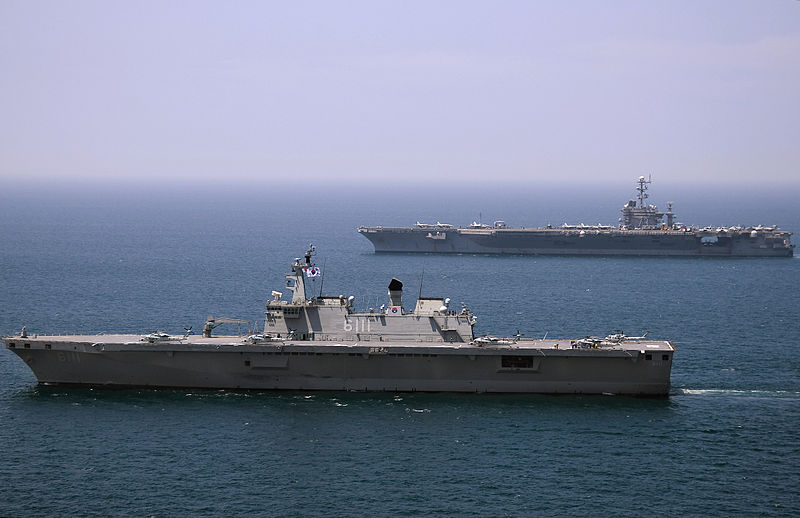
The Republic of Korea Navy amphibious landing ship ROKS Dokdo (LPH 6111) and the aircraft carrier USS George Washington (CVN 73) transit the Sea of Japan (July 27, 2010).
U.S. Navy photo by Mass Communication Specialist 3rd Class Charles Oki via Wikimedia Commons.
During May South Korea launched its second Dokdo class large amphibious ship, the 14,500 ton Marado. The first of these ships, the 14,000 ton LPH (Landing Platform Helicopter) Dokdo entered service in 2007 and the Marado is expected to follow in 2020. In addition to being a bit larger than the first Dokdo, the Marado has a number of new features that enhance its ability to operate as an aircraft carrier. This includes more capable electronics, many of them made in South Korea as well modifications to the flight deck and the hanger deck below.
Both 199 meter long Dokdos are similar in appearance and operation to the larger American amphibious ships. The LPH flight deck can handle helicopters, as well as vertical takeoff jets like the F-35B. The Koreans deny that the ship will be used with these jets, but the capability is there. The LPH normally carries 720 combat troops, a crew of 300, ten tanks, seven amphibious assault vehicle, three towed 155mm howitzers and ten trucks. Dokdos carry fifteen aircraft (two V-22 vertical takeoff transports and 13 helicopters) and two LCAC hovercraft in the well deck for landing troops.
The Marado has a redesigned flight deck that can handle two V-22s at once instead of just one. In addition to a more powerful 3-D surveillance radar for tracking aircraft, Marado has two Phalanx anti-missile systems compared to one Goalkeeper system on Dokdo. South Korea is also going to add a locally developed and manufactured K-SAAM anti-aircraft and anti-missile system. This is similar to the existing U.S. made ESSM but with longer range and an improved guidance system.
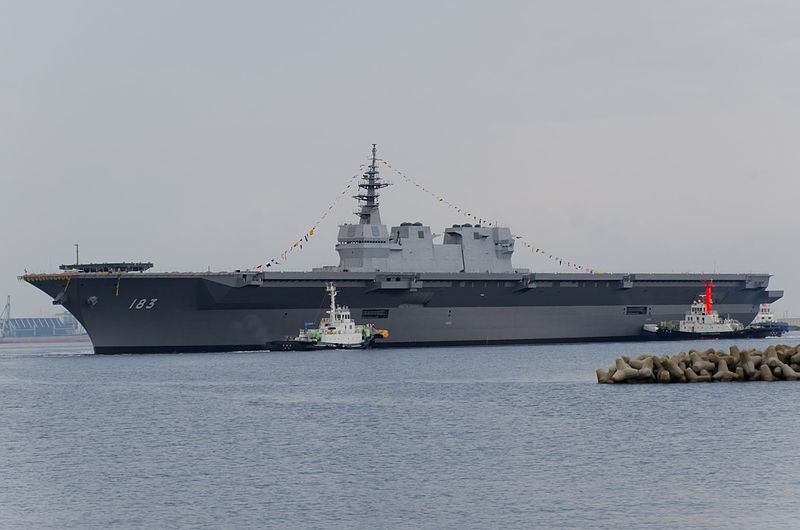
JS Izumo DDH-183, sister-ship of the JS Kaga DDH-184, both helicopter-equipped destroyers, officially.
Meanwhile, neighbor Japan has taken the Dokdo concept a bit farther. In early 2017 Japan put into service a second 27,000 ton “destroyer” (the Kaga, DDH 184) that looks exactly like an aircraft carrier. Actually, it looks like an LPH, an amphibious ship type that first appeared in the 1950s. This was noted when Izumo, the first Japanese LPH, was launched in 2012 (and entered service in 2015). The Izumos can carry up to 28 aircraft and are armed only with two Phalanx anti-missile systems and a launcher with sixteen ESSM missiles for anti-missile and anti-aircraft defense.
[…]
The Izumo is part of a trend. In 2009, Japan launched its second Hyuga class “LPH”. Earlier in 2009, it commissioned the first of these “helicopter-carrying destroyers”. This was the first Japanese aircraft to enter service since 1945. The Hyuga class are 197 meter (610 foot) long, 18,000 ton warships that operates up to eleven (mostly SH-60) helicopters from a full-length flight deck. Although called a destroyer, it very much looks like an aircraft carrier. While its primary function is anti-submarine warfare, the Hyuga will also give Japan its first real power projection capability since 1945. The Hyuga was also the largest warship built in Japan since World War II.
South Korea could adapt their Dokdos to handle a few F-35Bs by making the flight deck more heat resistant and rearranging the hanger deck. South Korea is getting land based F-35As which would enable them to determine if it would be worth the time and money to adapt their LPHs to carry some vertical takeoff F-35Bs. Sometimes peacekeeping missions involve some peacemaking and F-35Bs would help with that.

